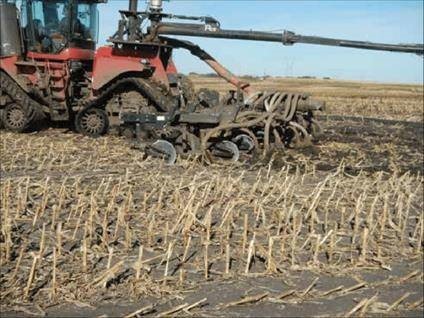Your Local Weekly Ag Partners Agronomic Update.
The one-stop-shop to hearing everything you need to know this week about what is happening in your fields.
This week’s featured agronomists are:
Adam Steffel- Belle Plaine
Storm Sammon – Owatonna
Chris Soltau – Goodhue
Zach Thompson- Lewiston
Luke Daninger- Ellsworth
Scroll down to hear from your local agronomist.
West
Belle Plaine – LeCenter – LeSueur
|
Adam Steffel |
After a great start to harvest, 2020 decided to put its twist on it and pile snow on top of the remaining crops in the fields. Prior to this snow, we were seeing some great yields out in the fields and seeing some great trends too. One big thing my growers and I have noticed is that the fertility is playing a huge role. I am probably sounding like a broken record but a great way to fix this is by taking soil samples still this fall or next spring, and spreading your fertilizer accordingly. Besides fertilizer we are also seeing different varieties stick out and perform well. |
Its never too early to talk to your agronomist about seed. The earlier we start bouncing ideas around, the more time we have to put together a well thought out plan for next year. We have a lot of great plot data to look at and it is always great to hear what the farmers are seeing with each variety out in their fields. This helps us compile the most information we can and make more sound decisions. And with so much happening in the soybean trait market we will be having a lot more conversations on what to go with for this next year.
Central
Wanamingo – Kenyon – Morristown – Owatonna
Join Storm Sammon, Owatonna Agronomist,
to hear a brief agronomic update.
Click on picture below:
South
Lewiston
|
Zach Thompson |
What a difference a week makes!! A week ago we had highs of 65 degrees and this week its looking like 35 degrees. Our trade area had snow fall amounts ranging from 2” to the North to just rain to the South. Our soybeans are 95% harvested in the area with only some beans after early peas left. Corn harvest is coming along nicely and its argument as to what percentage complete we are. The range is 20%-45%. Yields for corn and beans have been fair to exceeded expectations. |
Tillage: I think we need to take a closer look at our fall tillage pass. There was a lot of tillage that did not get done last fall due to weather challenges. The old adage of “a poor job in the fall is better than a good job in the spring” is still true. To me, the most important thing we need to do is get out and check the field to determine how deep we need to go. I have found that digging a hole and running a knife up and down the side to find the hard spot the easiest. The other option is a soil penetrometer. Without checking we are just guessing! We could be going too deep and burning unnecessary fuel or not going deep enough and hurting ourselves for the next year.
Feel free to reach out to your agronomist and we would be more than happy to help you determine the correct depth to plow.
Stay Safe!
East
Pine Island – Cannon Falls -Goodhue -Lake City
|
Chris Soltau |
Now that the soybeans have been harvested and there has been time to compare notes with other producers, you probably have heard soybean yields that ranged from 40-80 bushel/acre. Below is a check list of what I observed that either contributed to or took yield from your field(s) in 2020: |
Is your pH corrected and did you apply fertilizer to your soybeans? Having either of these two incorrect can take away 10 bushel/acre each.
Soybeans planted before May 15th added 3-5 bushel/acre.
Was the weed pressure low from May 15th to July 4th? Did they continue to stay clean after that? Managing weeds keeps 10 bushel/acre or more in your grain tank.
Did you apply fungicide and insecticide? Aphids were present in every field this year.
Add 4-15 bushel per acre if you sprayed a combination of fungicide and insecticide.
Diseases such as SDS and white mold can take up to 40 bushel/acre. The fungicides did help, however some areas of fields were robbed up to 40 bushel/acre this year.
If the field hasn’t been soybeans for two or more years, add 3-10 bushel/acre.
Most producers east of HWY 52 are blessed with tree lines, shallow soils, and the need for minimum tillage that make 40 bushel soybeans – which in these areas are considered a good yield. West of HWY 52 the producers have temporary lakes and swamps and higher speed winds that make 40 bushel beans excellent.
Control what you can and hope Mother Nature is on your side. Have a safe and terrific rest of your corn harvest.
WWAS
Ellsworth
|
Luke Daninger |
Soybean harvest is pretty much wrapped up in the area now and corn has made good progress, with about half of it done. Corn yields are thus far are coming in around average to above average. |
A Few Reminders-
-Don’t forget to let your AYS Specialist or Agronomist know about any trials you are harvesting that will need to be weighed.
-Even with the cold and snowy weather upon us this week, it is not too late to grid sample. We can sample as fields are harvested, which will allow us to spread them this fall yet or have the results ready to be able to utilize for spring. There is generally a cost savings and yield advantage of putting P and K down in the fall.
For the Dairy Guys-
Most of the manure is applied by now and went into ground that was well over 50 degrees at the time of application. With this in mind, it will be imperative to take nitrate tests in the spring to see what nitrogen is left from the application this fall. Once it is tested and we have the information, we can amend plans if need be.








